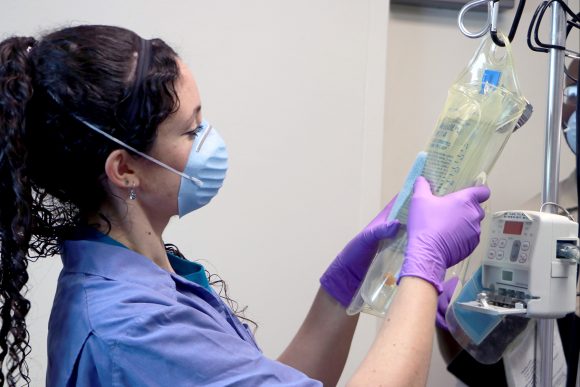
Hailing from Burnsville, Minnesota, Laurel Walosin has worked as part of our hospital staff for almost 6 years. Read on for a Q&A with her in honor of National Vet Tech Week!
Where were you before coming to Dallas Zoo?
Before coming to the Dallas Zoo, I worked as a zookeeper at the Minnesota Zoo and a veterinary assistant at a small animal practice in Eagan, MN.
What does it take to become a vet tech?
While acquiring an associate’s degree in veterinary technology may only take two years in an accredited program, becoming a zoo veterinary technician took a bit of extra time. I started by getting my bachelor’s degree in biology, then did an internship in zookeeping at the Minnesota Zoo. After that, I continued to work as a zookeeper and went back to school to get my applied associate’s in veterinary technology, then did yet another internship as vet tech at the Alexandria Zoo in Louisiana. So 6 years total in college, 2 unpaid internships, and multiple moves!
Describe a typical day at work.
The best part of this job is that most days are not typical. There’s always something that comes up and keeps us on our toes. If a day is typical, it starts with filling prescriptions, preparing treatments, and making sure everything is set up and ready to roll for any scheduled procedures. After a brief morning meeting with the entire hospital staff, we divide and conquer the daily tasks. The lab tech may step in to finish filling scripts and head out into the park to administer treatments on patients while the clinical technician heads out with the vets to do scheduled procedures (we alternate being clinical/ lab tech each week). Once procedures are finished, there’s a lot of cleaning up and putting things away that needs to be done. At some point within that time, the lab tech typically is packing up samples to be shipped and beginning to process samples coming in from procedures. Training sessions with various animals throughout the park happen in there somewhere, as well as hospital cleaning and maintenance, surgery pack wrapping and sterilizing, another round of filling prescriptions, and usually a couple unexpected emergency exams will pop up. Before the end of the day, setting up and packing for procedures scheduled the next day also happens.
What are some of the most challenging aspects of your work?
One of the most challenging aspects of working as a vet tech is learning to accept that you can’t save them all. We will deal with seeing animals at their worst. It is also a challenge to always be “on”. Everybody has tough days where we’re tired or not feeling well, but when we have a patient on the table, we have to focus on them and put anything else that’s happening behind us.
What are some of the most rewarding aspects?
Some of the most rewarding aspects of the job are definitely seeing an animal get through an illness and be happy and healthy again. Specifically, in zoo medicine, we also get to do a lot of training with the animals to help them participate in their own health care. We get to go out and help train these animals for behaviors such as voluntary blood draw, voluntary hand injections, blood pressure, etc. Seeing animals we’re working with succeed in training and give us a voluntary sample is the best feeling! It also allows us to build a positive relationship with that animal.
Who’s your favorite animal at the zoo?
I definitely have several that can always make my day! Katie the giraffe, Tullah the giant anteater, Hadiah the tiger, and Penny and Oliver kune kune pigs are on the list of animals that have my heart.
What do you do for fun outside of work?
I have been doing aerial acrobatics for about 4 years, and it has consumed most of my “outside-of-work” life. I practice on silks, lyra hoop, and static trapeze, so much of my time is spent in the air on one of those apparatuses. Aside from that, I love spending time with my pup! He’s hands-down my best friend and my baby all at once! (Here’s a photo of this dapper dog, Romeo, the black mouth cur.)


